Around the country, tucked away in rural workshops, converted stables and tiny, squeezed-in studio spaces are in fact some bits of kit that give the term ‘ageing press’ a whole new meaning. While most in print consider their kit ripe for an upgrade around the five-year mark, for some, the older the better.
Nineteenth-century Wharfedales, turn-of-the century Farleys and 60-year-old Heidelbergs – there are more historic presses dotted about the UK than you might imagine. And their output, with many still being put to commercial ends, might just surprise too…
Typoretum’s 1851 Albion and 1888 Wharfedale
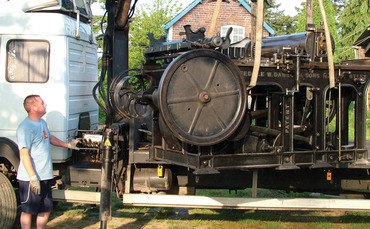 In pieces, under tarpaulin, in someone’s garden. This was the state in which Colchester-based Typoretum’s historic 1888 Wharfedale stop cylinder press very nearly met its end.
In pieces, under tarpaulin, in someone’s garden. This was the state in which Colchester-based Typoretum’s historic 1888 Wharfedale stop cylinder press very nearly met its end.
Fortunately for Typoretum, David Esslemont saved the day, rescuing the press and restoring it for special edition book printing at his Newtown, mid-Wales based Solmentes Press. When another turn of events nearly spelled disaster for the press once again, with Esslemont relocating to the states in 2004, Typoretum’s Justin Knopp came to its rescue.
In fact, even in its heyday the Wharfedale model encountered a fair few threats to its future security. The model was invented in its first iteration in 1830 by William Dawson, at a time when engineers worldwide were seeking ways to modernise the printing press.
The answer came in the form of a cylinder which rolled over a stationary bed, and was further enhanced by David Payne’s addition of a moving bed. And yet, revolutionary as this model was, the pair for a long time apparently made no effort to patent it. The result was the model being widely copied, with many firms even recruiting ex-Dawson, Payne and Elliott workers.
Not that this has made it any easier for Knopp to find people to help him maintain his 1888 Wharfedale. Despite the Wharfedale’s worldwide dominance for around half a century, with an order placed with Dawson, Payne and Elliott for 28 machines to print the Holy Koran on in Pakistan as recently as 1965, Knopp’s machine is, he thinks, one of the last, if not the last, working Wharfedale in the UK. (Ken McWhan of Scarborough had been using his for more than 70 years to produce posters, but closed his print shop in 2007.)
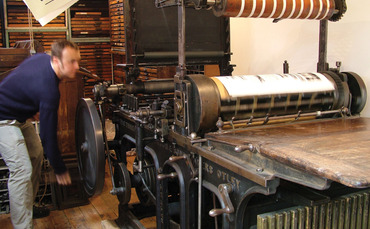 The result is that Knopp has to go to great lengths to find people to help him keep his machines going. “It’s really hard to find people with the skills and materials you need, foundries that will cast one-off pieces, for example,” he says. “The electrics on the Wharfedale probably date from the 1920s so getting an electrician to look at that is inevitably really outside their knowledge. The guy who helped me wire it up works on film sets and made a lot of props for Harry Potter films, so he’s got experience of playing around with electronics.”
The result is that Knopp has to go to great lengths to find people to help him keep his machines going. “It’s really hard to find people with the skills and materials you need, foundries that will cast one-off pieces, for example,” he says. “The electrics on the Wharfedale probably date from the 1920s so getting an electrician to look at that is inevitably really outside their knowledge. The guy who helped me wire it up works on film sets and made a lot of props for Harry Potter films, so he’s got experience of playing around with electronics.”
The same problem presents itself when it comes to Typoretum’s other pride and joy, an 1851 Albion hand press. Knopp acquired this press around 10 years ago from Wakefield College, seizing the chance to pay around £1,000 for it rather than the going rate of £3,000 to £5,000, due to it needing extensive renovation work.
“It was in quite poor shape when I got it. It needed a complete strip-down, just replacing things like belts and having a frisket frame made for it – they’re often missing, but you can’t do fine-quality close-register work without them,” says Knopp, adding: “The guy I bought the leather strapping from makes outfits for historical recreations such as mock jousts. He was just someone I found online; he just had this particularly thick strapping that’s hard to come by these days.”
Used in pretty much every print shop of a certain size in the early 20th century for posters, flyers, hand bills and broadsides, the Wharfedale at Typoretum is today used to create beautiful wood type posters the company sells from its shop, website and through various stockists.
The Albion meanwhile is used for proofing but also for more experimental wood type printing. “We tend to use the Albion a lot for proofing, which is actually really nice as that’s what they would have been used for in the past,” says Knopp.
“With a lot of the other presses – certainly vertical platens, and certainly the Wharfedale – you need to spend a lot of time locking things into a chase and doing a lot of makereadies to get a print. But because it’s purely a hand press you can get quite experimental with it. It’s a very direct process and no two prints will ever be the same.”
On how remarkable it is that his Wharfedale is still being used commercially, Knopp says: “I’ve got many friends who are ex-letterpress printers, and even the guys in their 70s and 80s have never used a Wharfedale press commercially, because those presses are so old that they’ve been obsolete throughout these guys’ entire working lifetimes.”
He adds: “They’re just such lovely machines to use. You feel very connected to them and their history.”
The Paget Press’s 1955 Heidelberg 10 x 15 platen, Intertype C4 linecaster and F Elrod strip caster
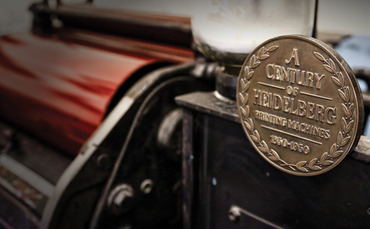 Terry Paget remembers vividly the day a brand new Heidelberg 10 x 15 platen press arrived at the print shop owned by his father. Which is remarkable considering that was nearly 60 years ago.
Terry Paget remembers vividly the day a brand new Heidelberg 10 x 15 platen press arrived at the print shop owned by his father. Which is remarkable considering that was nearly 60 years ago.
“It arrived when I was 15, just doing O Levels but on summer holidays. I remember it coming on the back of the truck – I was the first person to work it,” remembers Paget.
Even more remarkable is the fact that the 10 x 15 platen, and the Intertype C4 linecaster and F Elrod strip caster used to create type for the press, are still very much going strong. The machines were bought to use in the newly founded print shop in Midsomer Norton near Bath, with his father then going on to buy a second, larger platen to cope with the press’s predominant workload of delivery note and log-book printing for lorry delivery companies.
Paget sold this second Heidelberg machine after taking over the business in 1974. The business is still located in its original home of a vicarage’s converted stables, and has since invested in a Heidelberg GTO and, three years ago, in Konica Minolta digital kit, which Paget’s wife, an ex-IT technician, is responsible for preparing files for. And yet the old-school kit is still holding its own with the new machines, reports Paget.
“The Intertype machine often jams up and seizes, and the Heidelberg is getting old like me so it does go wrong, but by and large they’re very reliable,” says the 74-year-old Paget.
Paget still remembers his father’s excitement at having such an, at the time, sophisticated bit of technology brought into the print room. Heidelbergs were still a bit like gold-dust in 1955, he recalls, due to production stopping, with factories turned over to munitions-making, during the Second World War.
“By the time I worked the Heidelberg, I’d already operated a Thompson British press at the company my father worked at before setting up his own business. But my father was keen to have a Heidelberg as the means of paper transport was not so well evolved on the Thompson British,” says Paget.
He adds: “The Heidelberg picks paper up from the source pile and then hands over to grippers and they rotate a bit like a windmill and so maintain grip on the paper all the way round to the delivery, and release it onto precise sheet registers. The Thompson was different; it had a transfer method where the sheet was always being picked up and released. That wasn’t so reliable for precise registration.”
Today the 10 x 15 and hot metal machinery is used for draw and dance tickets. “Some jobs are still best done hot metal. You can do them litho, but it’s more difficult; with those short runs it’s better to do letterpress, I find.”
Paget Press is also increasingly asked to print decorative social stationery thanks to the letterpress renaissance of the past couple of years – much to Paget’s bemusement.
“I don’t understand it, when I was taught to print I was taught to kiss the paper and that you shouldn’t make a dent, otherwise it’s bad style!” he says. “I’ve had people come to me for menus and invitations who couldn’t believe their luck because I only charge £40 for a run that costs £100 elsewhere.”
He adds: “I used to have lots of hand type in trays and I’ve sold most of it to amateur printers and hobby printers. They love handling that, but I think it’s awful stuff – it’s so slow to use!”
In light of steady demand still coming Paget’s way, he doesn’t intend throwing in his hot type any time soon. “I don’t make a vast turnover, it’s about £50,000. It’s a hobby mainly. But I’ve no plans to retire. I shall retire when I either become too frail to do the work or the work dries up. But as long as it comes in, I’m happy to do it.”
Noble Fine Art’s three Heidelberg platens and Heidelberg KSBA cylinder press
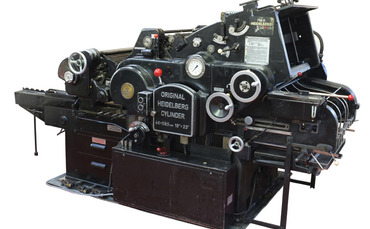 Watching the side of a building being removed and his new Heidelberg KSBA press being winched out, David Noble must have wondered whether it would all be worth it. The 1970 cylinder press had been at its previous owners so long that all of the other kit had sort of piled up around it, wedging it in.
Watching the side of a building being removed and his new Heidelberg KSBA press being winched out, David Noble must have wondered whether it would all be worth it. The 1970 cylinder press had been at its previous owners so long that all of the other kit had sort of piled up around it, wedging it in.
“It had been bought from new in 1970 and had been used originally for print but then when they’d moved everything over to litho they’d kept it just for cutting and creasing. It had been one of the first things installed. So there was a lot of head scratching to get it out!” reports Noble.
Noble, keen to put the press to work within his specialist print business Noble Fine Art, must have been worried too about the fragility of the machine. “You can destroy these kinds of machines pretty quickly, I’ve seen some horrors people have done through inattention,” he says.
“When you close the platen everything has to be in place,” he continues, referring to Noble Fine Art’s three other letterpress presses, all platen rather than cylinder models. “I remember seeing one where someone had closed the platen when the chase was partially removed. It destroyed the press in an instant; it fractured a casting, and once you’ve done that it’s scrap.”
Luckily, if treated with a bit of TLC, these letterpress machines are also remarkably hardwearing, says Noble. In fact, the strength of the build never ceases to amaze him. For Noble, the phrase ‘they don’t make ’em like they used to’ has taken on a whole new resonance.
“The great thing is these machines were designed in the 1800s, in an era long before consumerism had been thought about and so long before planned obsolescence. The idea was that you made something and you made it well and to last,” he says. “Just before litho came to the forefront it’s likely these machines were running three shifts a day, seven days a week and running at high speed to try to cope with this advancing new technology that was displacing them.”
Of just how well they were designed, Noble adds: “When Heidelberg really moved to litho presses, they took an awful lot of bits and pieces from the cylinder and carried them forwards.”
This quality design and build not only means Noble feels confident his two 10 x 15 platens, one 13 x 18 platen and KSBA cylinder press will be “still running after [he’s] gone”. It also means the quality of print coming off the machines is first rate. Something that suits Noble Fine Art, which Noble runs from a Yorkshire family farm with wife Julia, very well.
Noble cites a recent job, for a high-end property manager, as an example of where this high-end finish comes into its own. Business cards produced for this client featured five colours on one side, two on the other, a sleeve with five colours, foiling and cost around £2-£3 each.
“The print quality from the cylinder is exceptional,” says Noble. “The Heidelbergs are meant to be run to give long-term multiple consistency and the accuracy of them takes my breath away when you consider they’re 50 or 60 years old.”
He adds: “I do come across companies trying to fake it. There are various book publishers printing litho and running the print through a platen or rotary press to create a plate mark, but it always looks a little bit cheap.”
Luckily, Noble is finding plenty willing to pay just a bit more for his range of wedding, social and business stationery. And Noble will never tire, he feels, of how steeped in history and tradition his craft is.
“I love watching reactions when people come into the workshop,” he says. “They always say it’s like going back in time.”
Harrington & Squires’ 1920s Farley and 1920s Cefmor proofing presses, 80-year-old Cropper press and range of Adanas
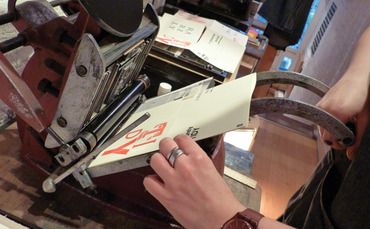 “I wonder what they think of us – two middle-aged women doing letterpress printing,” says Chrissie Charlton, co-founder of Tufnell Park-based Harrington & Squires letterpress workshop. And indeed to those old-school ex-printers selling presses and type to the likes of Harrington, their once industrial machines now being bought for high-end, craft printing, must seem odd.
“I wonder what they think of us – two middle-aged women doing letterpress printing,” says Chrissie Charlton, co-founder of Tufnell Park-based Harrington & Squires letterpress workshop. And indeed to those old-school ex-printers selling presses and type to the likes of Harrington, their once industrial machines now being bought for high-end, craft printing, must seem odd.
“You get to meet some great characters,” says Charlton, who founded the workshop with fellow graphic designer Vicky Fullick. “We sometimes get an email out of the blue from someone who used to be a compositor saying ‘I’ve seen your website, I’ve found some wooden type in the attic, would you like to make me an offer?’ We’ve got three or four cases of quite unusual stuff that way. And these people always have amazing tales to tell about how they did apprenticeships and how it was a completely different world.”
Such ex-jobbing printers must also find it a tad bizarre that old proofing presses are now so central to executing finished output. Among Harrington’s larger machines are proofing presses from Farley and Cefmor, which, while they can now be used by fine artists for linocut printing, are used mostly by Harrington for its larger, A3 wooden type pieces.
“Those would have been used by typesetters for proofing a galley of type just to check there were no typos, to check they hadn’t got any the the wrong way round, or the wrong font before they put it on the press,” says Charlton. “But we use them for final products because they’re very good for using with wooden type, and it means we can print larger than on our Adanas.”
And despite inhabiting a 1.2m-wide, three-storey studio space, (aptly named The Corridor), Harrington has now set its sights on producing even larger prints. The duo invested just a couple of weeks ago in a 80-year-old Cropper treadle press.
The team apparently just couldn’t turn down such a sought-after and highly respected model. Croppers first went into production in 1839 when Radford-born businessman, pillar of the local community and Sherriff of Nottingham, Henry Smith Cropper founded HS Cropper & Co. The machines gained such traction in the UK that ‘Cropper’ became the generic term for all jobbing platen presses in the UK, with some even believing that ‘come a Cropper’ derives from the accidents print workers suffered when catching their fingers.
“Because we work in such a tiny space we have always thought we couldn’t have anything bigger, but actually this is a real find,” says Charlton. “We were very lucky we could fit this downstairs in our lobby. We work in a very narrow space and we couldn’t possibly get it up the stairs. We’ll have something that can print 13 by 9 inches which is huge!”
Not that Charlton and Fullick intend on dispensing with their 13 much smaller Adana hand presses any time soon. These still produce the core of the workshop’s greetings card, calendar and magnet work.
Again, original Adana fans would probably be surprised at their use here today. Enjoying their heyday in the early and mid 20th century and now no longer in production, the Adana was designed for hobby printers. In fact they first went into production at a time when suppliers generally didn’t approve of the hobby printer, with the manufacturer stating at the time: “We are not among those who are alarmed at the increase in amateur printing in this country, though we will not encourage it.”
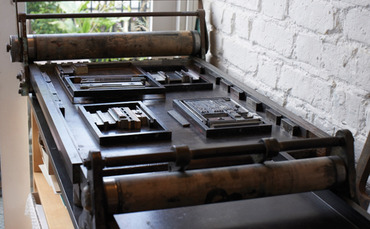 While many are still used in this amateur capacity, there are also an increasing number putting them to more commercial use now, reports Harrington. Which makes the £100 Harrington & Squires paid for their first Adana and 10 cases of type look a very good deal indeed.
While many are still used in this amateur capacity, there are also an increasing number putting them to more commercial use now, reports Harrington. Which makes the £100 Harrington & Squires paid for their first Adana and 10 cases of type look a very good deal indeed.
Not that these are the easiest machines to work with. “You get to know each press’s individual quirks, particularly with Adanas which are very simple and unsophisticated machines,” says Charlton. “The bad side of them being unsophisticated is that they can be slightly prima donna-ish. You can have three or four days of printing beautifully and then you put another job on the press that’s a different weight card and you can’t get the right impression.”
But generally the result is surprisingly good. “We seem to get very good results from them,” says Charlton. “Sometimes people look at stuff we’ve done and ask ‘did you really do that on an Adana?’”










